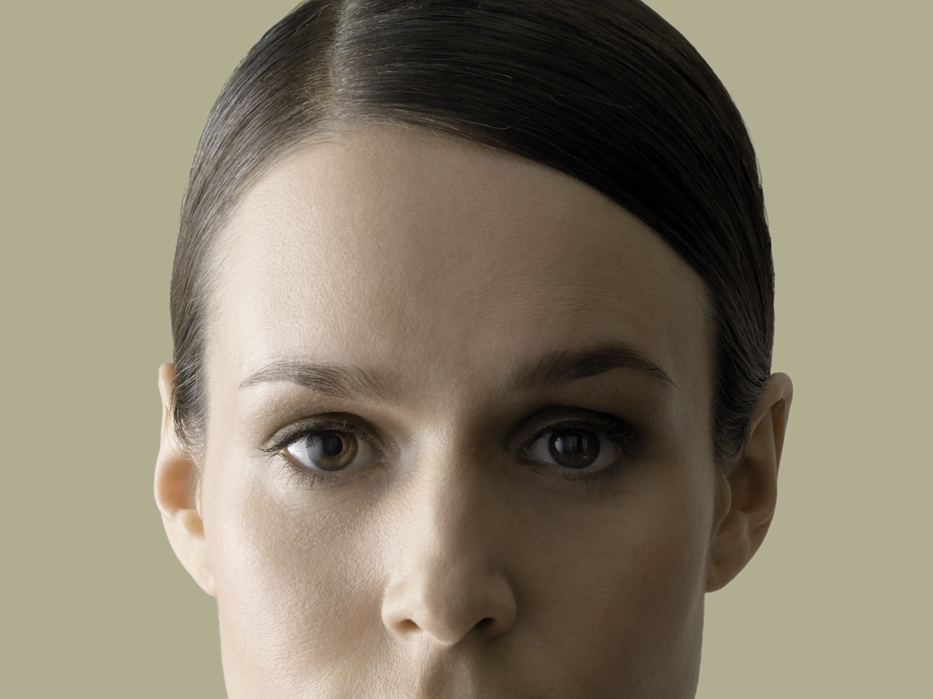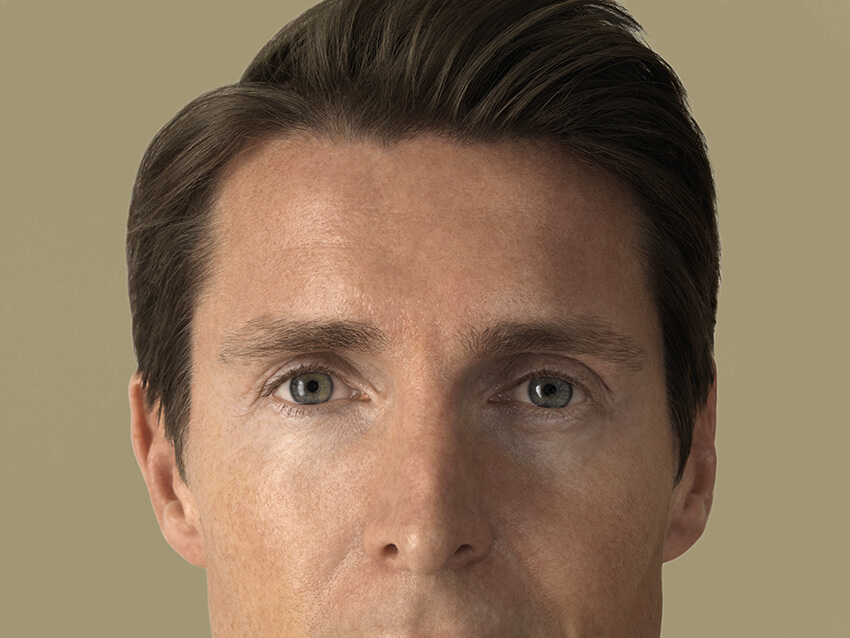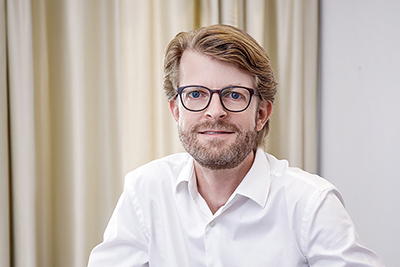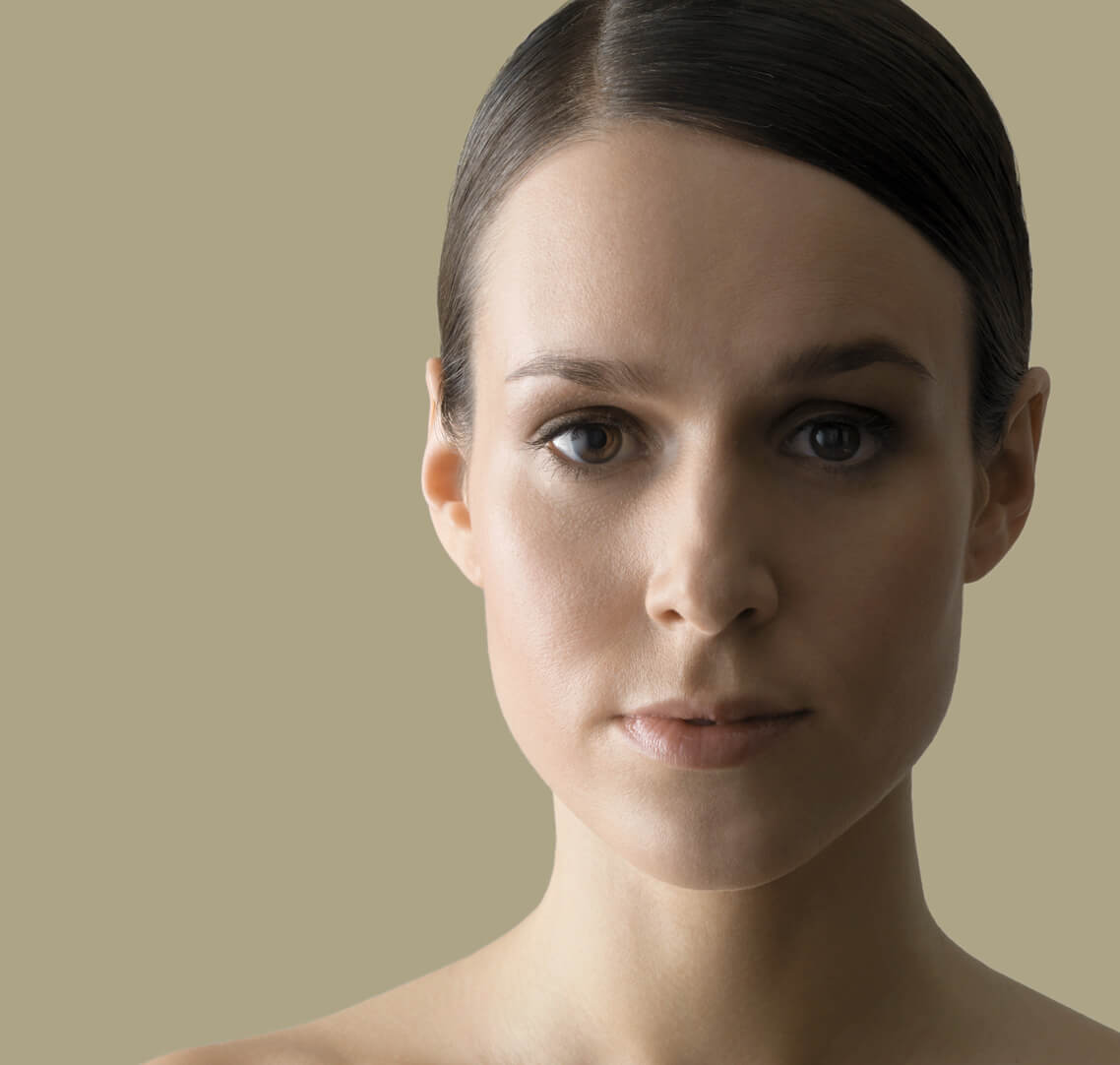
The eyes are the focal point of a face. Judgements about a person’s character are often made from their appearance. Eyes with a downward inclination appear to be sad and tired, whilst eyes with an upward inclination appear fresh and full of energy. Dark rings under the eyes can appear even in youth and create the impression of tiredness or sickness. Thus many people suffer from the fact that the expression of their eyes, and therefore of their face, does not coincide with the perception of themselves.
Because the skin of the eyelids is especially thin and sensitive, the aging process is often seen on the eyelids first (dermatochalasis). Eyelid skin can show early signs of aging if you are susceptible to allergies, have weak connective tissue (blepharochalasis), or due to lifestyle.
- Droopy eyes are due to an excess of eyelid skin, where the upper lid skin (lid fold) hangs over the crease of the eyelid.
- Upper eyelids can also bulge due to fatty deposits that make the eyelids appear swollen.
- Swollen lower eyelids are caused by a bulging of fat deposits caused by a true excess of fatty tissue or a weakening of the connective tissue of the lower lid that allows the fat to prolapse.
- Dark circles under the lower eyelids may result from shadows under prolapsed fatty tissue (tear trough deformity) or may be due to hyperpigmentation.
- The lower lids often droop with age, exposing more of the whites of the eyes (scleral show).
- In severe cases, the lower eyelid may even evert and loose contact to the eyeball (ectropion). This may not only cause cosmetic but also functional problems, such as dry eyes and chronic irritation or inflammation.
- Skin on the upper and lower eyelids loses elasticity with age and becomes wrinkled. This aging effect is intensified by muscles around the eyes creating deep laugh lines that can stretch across the cheeks.
Many people suffer from these changes in appearance and can benefit greatly from eyelid surgery (blepharoplasty) to improve the eye contour. The effect of eyelid surgery usually persists for many years, in some instances even for a lifetime. Lid surgery can even improve eye function in some cases.
Generally one distinguishes between an upper and lower eyelid surgery though both can also be combined in one procedure.
Upper lid surgery: Excess skin, as well as fatty tissue of the upper eye is either removed or redistributed. The aim is to create a youthful convex shape of the upper lid, which is why surgeons try to preserve muscle and fat tissue as far as possible.
Lower lid surgery: In contrast to the upper lid, the lower eyelid usually has far less skin excess, requiring little or no skin removal. Generally, the lower lid contour is defined by the removal or redistribution of fatty deposits and the correction of lid weakness. Frequently, sagging of the lower eyelid is corrected by tightening of the ligaments that suspend the lower lid.

Considerations
When to consider eye surgery?
If you have:
- Loose, excess skin on the upper lids that, in extreme cases, can impair vision
- Swollen appearance of the upper lids that makes the eyes appear tired
- Excess or wrinkled skin on the lower lids
- Bags or dark rings under the eyes that give a tired or sickly appearance
- A change in eye shape, e.g. due to a downward inclination of the lid axis with drooping of the lower lids (scleral show)
- Functional problems, such as ectropion
Laugh lines around the eyes cannot be corrected by plastic surgery. To remove these Botulinumtoxin-A injections, a chemical or laser peeling is necessary. Dark rings under the eyes can be improved with lower lid surgery often combined with fillers or with fatty deposits from the patient themselves. Dark pigmentation can also be lightened by bleaching.
Before an operation it is important to ascertain if changes on the eyelids could be due to tiredness, stress, exhaustion or even an illness (e.g. kidney function, heart problems or thyroid problems), in which case an operation would not be advisable. If concerns are purely cosmetic and the patient is otherwise healthy, then an aesthetic correction is worthwhile.
A tired or gloomy expression can be due to a low position of the brows and sagging facial tissue. In this case eyelid surgery can be combined with a brow lift. Sometimes a brow lift in itself can not only elevate the brow position but also lift the upper lids, thereby reducing excess eyelid skin.
Consultation
A prerequisite to a successful operation is careful planning. This starts with a personal consultation.
- Communication of wishes, expectations, ascertain what you would like to improve
- Explanation of the possibilities and scope of the operation
Examination:
- Medical history is taken
- Physical examination is performed
- Digital photos are taken
- Thickness, texture and elasticity of skin is tested
To plan the operation and to make a risk assessment we require:
- Full medical history
- Allergies or aversion to medications
- Any important medical reports
- Whether you wear contact lenses
- Comprehensive information about any eye problems/disease, such as dry eyes, impaired vision, etc.
Procedure
Various surgical options are available depending on specific factors for each individual patient:
- Amount of excess skin and fatty tissue
- Position of eye brows
- Function of lid muscles, eyelid and tear ducts
Upper eyelid surgery: Upper blepharoplasty aims to create youthful looking eyes. Excess skin and fat deposits are removed or redistributed, preserving enough tissue to create a youthful convex upper lid shape. Scars from the removal of skin are well hidden in the upper lid crease, and are hidden in the laugh lines or wrinkles on the side.
Lower lid surgery: An incision is made beneath the eyelashes from where excess skin (usually far less than at the upper lid) and fatty tissue can be removed or redistributed. Scars are concealed under the eyelashes or in a crease. Frequently excess fat tissue from bags under the eyes can be used to correct fill the cheek and correct dark circles under the eyes. Lower lid looseness or sagging is corrected by tightening of the lid ligaments and lower lid muscle.
Risks
All operations carry risks. Although complications are very rare, in some cases they can be serious and can even lead to blindness if not recognised and treated. Thus, before every eyelid operation the eye function is thoroughly examined and in some cases an examination by an eye specialist is recommended.
Impaired eyelid function –usually temporary– is more common in lower than in upper lid surgery. In cosmetic eyelid surgery even more strict standards are applied than with other medically indicated eyelid procedures. General risks from surgery include:
- Eye dryness
- Foreign body sensation (A feeling as if something is stuck in your eye)
- Redness, swelling of the conjunctiva (chemosis)
- Teary eyes
- Eye secretion
- Haematoma (bruising), bleeding and swelling
- Healing problems or infection
- Wound dehiscence (separation of sutures)
- Injury of nerves or vessels
- Numbness in area of operation (temporary or permanent)
- Circulatory problem of eyelid skin (skin slough)
- Scars
- Slight asymmetry
- Lower lid malposition (Ektropion)
- Unsatisfactory aesthetic result
- Secondary surgery
Overall eyelid surgery is a safe procedure when undertaken by an experienced plastic surgeon and patients are mostly satisfied with the r
Preparation
Our aim is to make the time before and after the procedure as comfortable as possible. By following a few recommendations you can support our care:
- To aid the healing process avoid smoking for two weeks before and after the operation.
- Avoid medication that increases the risk of bleeding, like aspirin, non-steroidal anti-inflammatory drugs, as well as vitamins and homeopathic remedies for two weeks prior to the operation.
- Eyelid surgery is mostly performed as an outpatient procedure under local anaesthesia. However, if you choose surgery to be performed under sedation or general anaesthesia, make sure that you can be collected and cared for by someone for 24 hours after the procedure.
Day of surgery
In most cases eyelid surgery is an outpatient procedure that can be performed at the AARE KLINIK. In individual cases, when necessary, the procedure can be undertaken in an affiliated private hospital
- During the operation you will receive various medications for your wellbeing.
- Depending on individual cases and the length of operation, you will have a local anaesthesia with sedation or a general anaesthesia.
- For your safety, your heart rate, blood pressure, oxygen supply etc. are monitored during the operation.
- At the end of the surgery a special protective dressing will be applied that allows the eyes to open.
- Due to the dressing, some swelling after surgery and the use of a protective eye ointment, your vision may be blurred.
- Immediately after surgery your head position should be kept above the level of your heart to reduce swelling.
- The eyes should be cooled at intervals with cold and moist gauze to prevent swelling and speed up recovery.
- You can return home a few hours after the operation.
- If you are an inpatient in hospital then you will remain there until the following day.
- If you are an outpatient and surgery was performed under sedation or general anaesthesia you should have someone to care for you continuously for 24 hours after surgery.
- We also offer the possibility for a short inpatient stay at the AARE KLINIK if required.
After surgery
- It is important to realise that recovery from an operation varies for every individual.
- During the first days after eyelid surgery you should keep your head in a raised position and place cold and moist gauze over the eyes to prevent swelling and eye dryness.
- Only take prescribed pain medication and do not take medication like aspirin.
- During the first days after the surgery you might experience a feeling of tension and light pain in the eyes, which can be alleviated with the use of prescribed pain medication.
- Bruising reduces within 7-10 days and can be covered with makeup after a few days.
- Your sight might be slightly blurred for a few days.
- You might be sensitive to light and might have dry or teary eyes. Wearing sunglasses and using eye drops and eye ointment can alleviate burning or itchiness.
- Reading and watching television should be kept to a minimum as they tire the eyes.
- You should avoid bending, exertion and lifting in the first days after the operation.
- Do not exert yourself or do sport and avoid heat (e.g. bathing, sauna, solarium) for a few weeks until all swelling has subsided.
- The dressing and stitches will be removed after 5–7 days.
- Use a skin moisturizer to help heal the scar, which should be protected from sunlight for 3 months.
- Generally you can return to work after 1-2 weeks.
You will have numerous postoperative check-ups at the AARE KLINIK to make sure your recovery is optimal.
Outcome
Cosmetic eyelid surgery makes one look rested, fresh and more awake.
- Due to the healing process and swelling, it takes a few weeks before the outcome of an operation can be fully evaluated.
- Scars fade within 2-3 months and with time are hardly visible.
- The effects are long-lasting, but are influenced by your genetic makeup and life style choices.
- With time the skin will age and wrinkles can reoccur.
- Skin excess of the upper lids may reoccur due to aging and lowering of the brows, which can be corrected with a brow lift.
- Despite this most patients remain pleased with their eye surgery for many years.
Costs
Mostly, eyelid surgery is seen to be a purely aesthetic measure, in which case the costs are not carried by health insurance. However, sagging upper lids can lead to restricted vision, and in those cases eyelid surgery may be covered by medical insurance. The costs of lid surgery vary depending on the scope of the surgery and where it is undertaken (AARE KLINIK/hospital) and can only be ascertained after a personal consultation.
The overall costs are made up of:
- Surgical fee (including consultation and post-operative care)
- Anaesthesia fee • Technical infrastructure costs (AARE KLINIK/hospital)
- Inpatient hospital costs • Medication
- Diagnostics (laboratory, ECG, scans, etc.)
Appointments for eyelid surgery with Dr. Scheufler in Bern
Before any eyelid surgery you should have a comprehensive consultation and additional examination. Only in this way can you be sure whether the type of surgery will lead to the result you expect. In addition, your consultation will give you a good impression of our experience in the field of facial surgery. Feel free to ask for before and after photos to get an idea of what the results look like.

Dr. med. O. Scheufler, specialist in plastic, reconstructive and aesthetic medicine and author of this website, is pleased to be at your service for a personal consultation. Besides his main work at the Aare Clinic, PD. Dr. Scheufler is also scientifically active and has habilitated at the University Hospital of Basel. He was therefore awarded the title of assistant professor by the University of Basel. In addition, he was honored by Duke University (USA) as a Visiting Professor. So do not hesitate to contact him if you wish a professional consultation!



